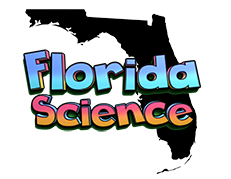SC.5.P.8.4 Particles of Matter
SC.5.P.8.4: Explore the scientific theory of atoms (also called atomic theory) by recognizing that all matter is composed of parts that are too small to be seen without magnification.
What is Matter Made Of?
All matter is made of particles, or pieces, too small to be seen. Molecules like water (H2O) or carbon dioxide (CO2) might already be familiar to you. Molecules make up all the matter around you: solids, liquids, and gasses.
Even molecules are made of smaller particles called atoms. Both water and carbon dioxide contain atoms of oxygen. But the physical properties of water, carbon, dioxide, and oxygen (O2) are very different. Plants can use the energy of the Sun to combine carbon dioxide and water to make a new molecule of sugar. The plant uses the sugars made this way for food. When plants complete this process, there is always left-over oxygen. The plant does not need oxygen, so it gets rid of this waste molecule.
Molecules and atoms are particles of matter that are too small to be seen without a microscope. Even then, only the most powerful microscopes can see molecules. Even these microscopes can only see molecules as very fuzzy images.
Atoms combine in different ways to form different molecules. As we already saw with oxygen, it combines with other atoms to make carbon dioxide and water. Oxygen also combines with iron to form rust. All matter, solids, liquids, and gasses, are made of particles too small to be seen without magnification.

